Whipping Egg Whites

What do “soft peaks” look like? What about “stiff peaks”? How do you know when you’re over-whipping? These are some of the great mysteries of egg foam making. But I say: let them be mysteries no longer! Let’s have a picture tutorial that will clear the air on this once and for all! Because being anxious over the height of your egg foam is one sure way to suck all the fun out of a baking project. Read this and go forward with confidence, friends. Making a perfect whip is easy if you know what to look for.
Here I have four perfectly good egg whites that I’m about to ruin. Don’t tell Mrs. Pastry, OK? She abhors waste in any form however small and I don’t want to get in trouble. This is just between us. You can see I’ve placed the whites in my (im)perfectly clean copper egg bowl. But then these things are a pain to keep free of tarnish. Here I’ll say that a copper egg bowl really is the best vessel for whipping whites for reasons I have explained here. As for an instrument you can’t do better than a hand mixer which lets you move all around the bowl and attack any un-whipped bit of egg white. If you don’t have these tools it’s not a problem, the same rules still apply.
These egg whites are quite fresh and firm, but that’s not important for a successful whip. In fact older eggs generally whip up faster and better. Old whites are more liquid than gelatinous, you see, and that’s a good thing when you consider that whipping is a factor of applying shear force to the proteins in the white. It’s easier to do that when the whites are thin rather than thick. Consider: which liquid will a whisk cut through with more speed — water or honey? I trust you see my point. Off we go.

Now then, I begin to whip on 50% power so the liquid whites don’t fly all over my brand new shirt. After about 20 seconds I’m starting to make progress.
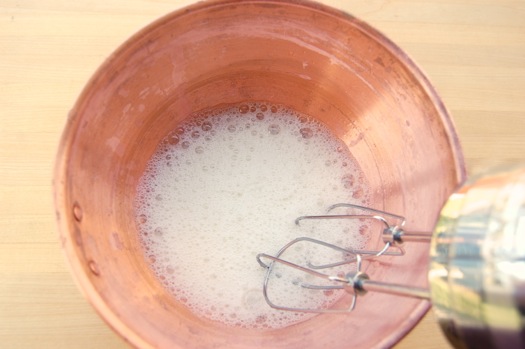
I up the power to 75% and keep whipping for about another 30 seconds. Here you can see the whites are starting to get really foamy and take on some body. If you don’t have a copper bowl like the one pictured here and you want to add some cream of tartar or lemon juice to help protect you from over-whipping, this is the point tot add it. This is also where you want to start adding sugar if you’re making meringue.
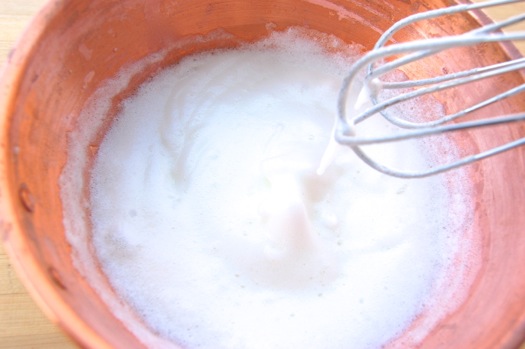
I crank up the power to 100% and whip for about another 30 seconds. Here you can see I’m approaching the zone. These aren’t quite soft peaks as they flop over too easily. Also look on the beater there: nothing but blobs on the ends. Keep going.
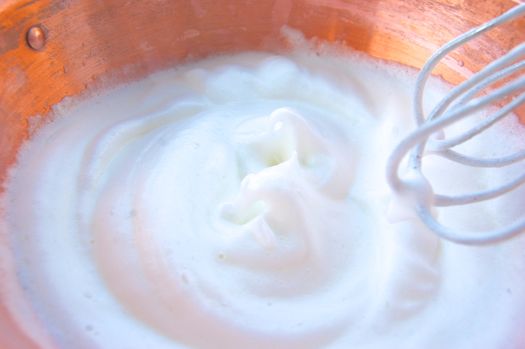
Another 20-30 seconds and I’m at the soft peak stage. The mass of whites is silky and almost elastic. See those lovely curls and the way the tips of the whites droop gently down off the beaters? Just about perfect soft peaks.

If you’re the sort of person that likes the bowl tip test, you can do that. The whole mass should stick and not slip around.
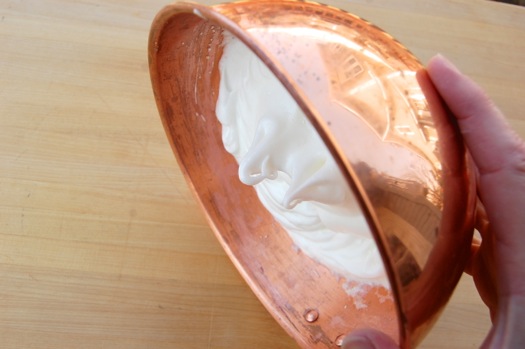
Another 20-30 seconds on high and I’m at the stiff peak stage. The whites have lost any of the elasticity they had and are as firm and voluminous as they’re going to be. Peaks are straight up when I lift the beaters and stick straight out off the implements themselves.
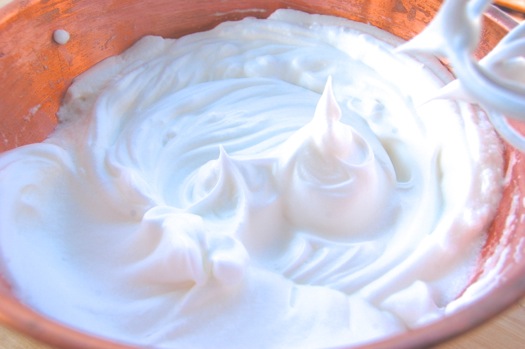
OK. Now I’m going to push it and go on. After another full minute on high I’m at what some people like to call “dry peaks”. The whites still form peaks when you lift the beater up. But the silkiness is starting to disappear and be replaced by a grainy appearance caused by clumping proteins. They’re still usable, but the foam isn’t as strong as it once was, and I’m actually starting to lose volume.
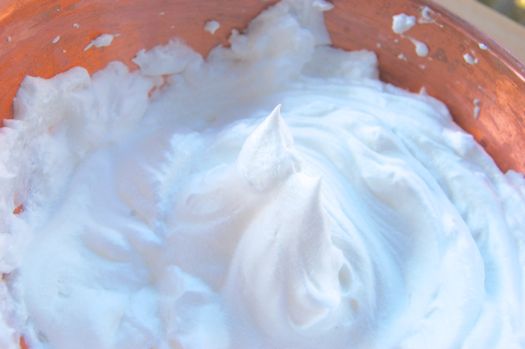
Another minute on high and I’m well over-whipped. The whites don’t even form peaks anymore, and look like mounds of cottage cheese. I’ve lost a good third of my volume and liquid is starting to accumulate at the bottom of the bowl, water that’s been squeezed out by clenching proteins. These whites aren’t useful for anything,
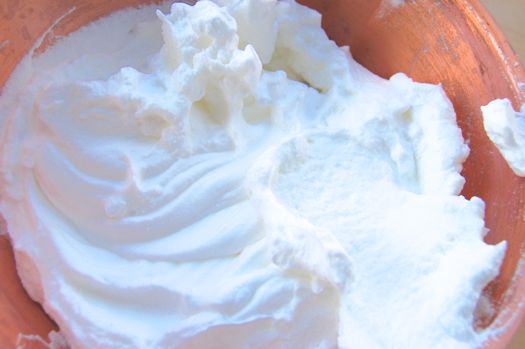
However it’s reassuring that it took so long to ruin some whites, isn’t it? I had a rather narrow window between soft and stiff peaks, but quite a large one between stiff and dry peaks. That’s the margin of error that a copper egg bowl buys you. So I hope this has been helpful. And again, don’t tell my wife, K? I’ll be in for it unless I can prove I ate these with a spoon after the demonstration was over. Blechhh.
So Very Helpful! A picture is worth a thousand words… couldn’t be more true in this case. 😀
Thank You Joe! I finally see the white… uh er light! 😉
Eva
Ha! My pleasure, Eva!
– Joe
julia child used to say that if you overbeat your whites and they turned grainy you could salvage them by beating in some raw egg white. have you ever tried that?
from another source:
Can overbeaten egg whites be salvaged?
“All is not lost. As long as you haven’t added any other ingredients, you can usually resurrect a foam by adding an extra egg white and beating just until the mixture looks glossy and forms peaks again.”
Very nice, Ascanius! I have not heard that before but it makes sense. Cheers,
– Joe
I can attest that this works. I keep separated eggs whites in containers, so I haven’t ever added a whole ‘nother egg white – just drizzle in a tablespoon or so, blend it thoroughly with the whipped mass, and then tighten it all back up again with your beaters on high.
I’ll try it the next time i get in trouble, Ruth (which will be soon knowing me).
Thanks!
– Joe
Why is that some recipes for White Cake (with creamed butter and sugar) call for egg whites to be whipped separately with no sugar while others instruct to do the opposite?
Back when I first started baking, I attempted White Cupcakes using a recipe that said only to beat the whites (no sugar) to stiff peaks and fold them in. Everything seemed fine – until I took them out of the oven and realized the whites had sunken into the middle of each cupcake. They tasted “eggy,” too, which was really off-putting.
It wasn’t until I began adding a small amount of reserved sugar to the egg whites that my (white) cupcake batter rose in the oven (and I haven’t had a problem since).
Just thought I’d ask 🙂
Hey Andrew!
Between the two, I’d definitely do what you’re doing: add the sugar. The syrup that forms when the sugar dissolves into the egg whites shores up the bubble walls and helps keep them from popping. Basically you’re making a light meringue. Nice work on that!
Cheers,
– Joe
Thanks for the demonstration and for the egg white sacrifice :-). If you’re adding sugar, do you add it at the same time as the optional acid? Do you ever add salt? Does the sugar affect the potential of over beating? So many questions and probably not the right place…
Great point, Maria. You’re right, the point where the foam is starting to whip up is where you start adding sugar as well. Nice catch.
As for the salt, there’s a post on that right below this one. Indeed sugar does help mitigate the risk over over-beating though it doesn’t completely eliminate it. Especially if the meringue is going to be added as an ingredient to a batter, you have to know where to stop lest the bubbles get too big, the foam rises too much and the whole thing collapses. Great questions!
Thanks,
– Joe
I read a lot of cooking blogs/sites. But this post is why this blog is one of the more useful online. Do you know how many times people say “soft, stiff, firm etc…” without demonstrating exactly what they mean. A lot.
Show me the money. Which JP does, again.
Thank you.
Love your kielbasa, Abe. Just had to say that.
But thank you for all the very kind words. I love what I do!
– Joe
Thanks Joe! Incredibly helpful. I’ve now learned that all this time I’ve only been beating to the soft peaks stage thinking that I had achieved stiff peaks when in fact I hadn’t gotten there yet – all due to a fear of over-beating.
Hey Deb!
Yes it helps to see these sorts of things done. Don’t know why I never have done this before. I’ll do the same thing with whipped cream this week when I make the filling, just in the interest of thoroughness!
Cheers,
– Joe
Hello,
I was attempting to make your opera cake recipe and failed twice to get my egg whites to whip. I watched the eggs both times and they seemed to go from frothy to overbeaten without ever reach the soft or stiff peak stages. I cleaned my bowl and whisk with vinegar and wiped them dry and had the whites at room temperature. The only thing I can think of is that I started off too quickly (at medium speed). Do you have any suggestions? I would still like to try the cake as I have already made the coffee buttercream. Thank you.
That is very puzzling, Vanessa. Perhaps if you could send me some pictures of the process, because I’ve never heard of this problem before!
We will get it sorted out though. Use the email link on the upper left.
Cheers,
– Joe
I didn’t take pictures this time but when I attempt to make it again, I will. Thank you!
Please do. Talk to you soon, Vanessa!
– Joe
Hi Joe,
I saw that you’ve been out of town enjoying the bluegrass of Kentucky! I sent some pictures to your email but wanted to post here in case you didn’t receive/see them due to email volume during your trip. I’m interested to get your opinion based on the photos.
I’ll look again, Vanessa, as I want to see you progress!
Thanks for the reminder!
– Joe
what is beaten egg white & sugar called? I am translating from german for a friend
Meringue!
– Joe